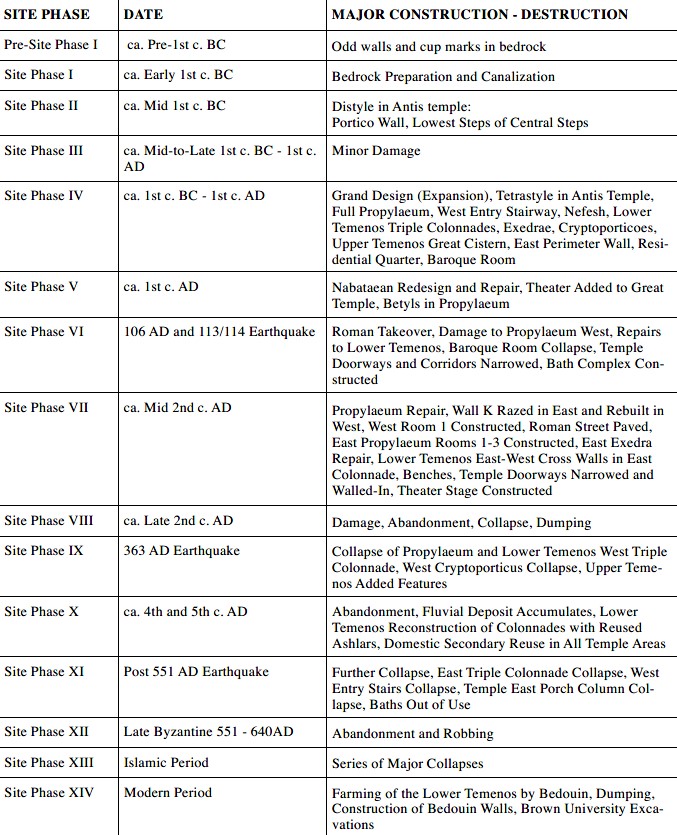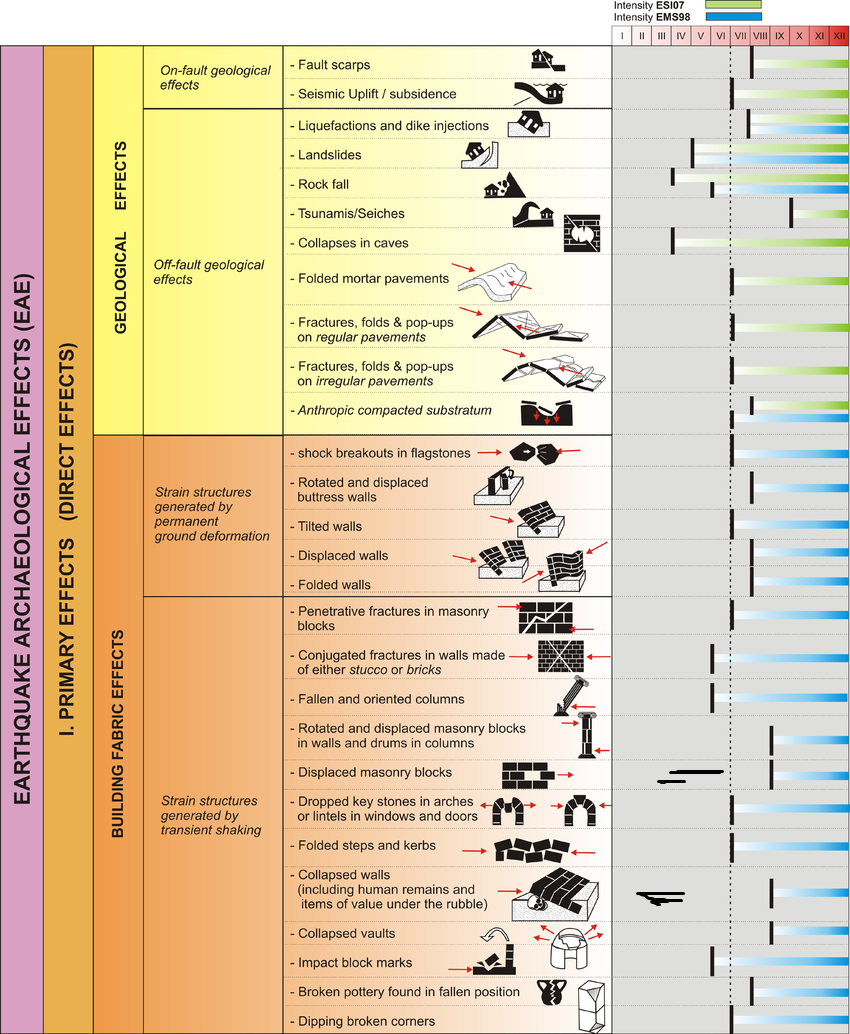Petra - The Great Temple
 The Great Temple of Petra
The Great Temple of PetraWikipedia - CC BY-SA 3.0 - Bernard Gagnon
The Great Temple is one of the largest surviving structures of Petra.
- from Petra - Introduction - click link to open new tab
- The Great Temple in Google Earth
- Fig. 1 - Aerial View of the
Great Temple at Petra from Joukowsky (2015)

 Fig. 1
Fig. 1
Aerial view of the Petra Great Temple precinct at the close of the 2006 excavations, to south
(Photograph by Artemis W. Joukowsky)
Joukowsky (2015)
- Fig. 2 - Site Plan of the
Great Temple at Petra from Joukowsky (2009)

 Fig. 2
Fig. 2
Petra Great Temple site plan (Marshall C. Agnew).
Joukowsky (2009) - Site Plan of the Great Temple
at Petra from Wikipedia
- Fig. 2 - Site Plan of the
Great Temple at Petra from Joukowsky (2009)

 Fig. 2
Fig. 2
Petra Great Temple site plan (Marshall C. Agnew).
Joukowsky (2009) - Site Plan of the Great Temple
at Petra from Wikipedia
- Fig. 2 - Phase II plan
from Joukowsky (2015)

 Fig. 2
Fig. 2
Great Temple plan, phase II
(Marshall C. Agnew)
Joukowsky (2009) - Fig. 4 - Phase IV plan
from Joukowsky (2015)

 Fig. 4
Fig. 4
Great Temple plan, phase IV
(Marshall C. Agnew)
Joukowsky (2009) - Fig. 12 - Phase V plan
from Joukowsky (2015)

 Fig. 12
Fig. 12
Plan of the theater-in the temple, site phase V
Joukowsky (2015) - Fig. 10 - Phase VI plan
from Joukowsky (2015)

 Fig. 10
Fig. 10
Roman-Byzantine baths, plan
(Marshall C. Agnew and Eleanor Power)
Joukowsky (2009)
- Fig. 2 - Phase II plan
from Joukowsky (2015)

 Fig. 2
Fig. 2
Great Temple plan, phase II
(Marshall C. Agnew)
Joukowsky (2009) - Fig. 4 - Phase IV plan
from Joukowsky (2015)

 Fig. 4
Fig. 4
Great Temple plan, phase IV
(Marshall C. Agnew)
Joukowsky (2009) - Fig. 12 - Phase V plan
from Joukowsky (2015)

 Fig. 12
Fig. 12
Plan of the theater-in the temple, site phase V
Joukowsky (2015) - Fig. 10 - Phase VI plan
from Joukowsky (2015)

 Fig. 10
Fig. 10
Roman-Byzantine baths, plan
(Marshall C. Agnew and Eleanor Power)
Joukowsky (2009)
- Fig. 5.17b - Photo of inner
wall of the west corridor showing two phases of construction from Rababeh (2005)

 Fig. 5.17b
Fig. 5.17b
Photo of Inner wall of the west corridor showing two phases of construction
Rababeh (2005) - Fig. 5.17c - Drawing of inner
wall of the west corridor showing two phases of construction from Rababeh (2005)

 Fig. 5.17c
Fig. 5.17c
Detailed drawing of Inner wall of the west corridor showing two phases of construction
Rababeh (2005)
- from Joukowsky (2009)
 Figure 3
Figure 3Petra Great Temple Chronological Chart of Site Phases.
Joukowsky (2009)
Joukowsky and Basile (2001:50) noted that Nabataean-Roman Phase IV "dated to the mid-second century" follows "a minor collapse when the uppermost course of the propylaea stairs was built to provide access to the Lower Temenos, and when the Lower Temenos cryptoportico, which may have seen collapse, was filled in."
Joukowsky (2009) attributed the Phase IX earthquake to the southern Cyril Quake of 363 CE.
Although Joukowsky (2009) attributed seismic destruction to the 551 CE Beirut Quake, the epicenter of this earthquake was too far from Petra (almost 400 km.) to have caused such damage. The Inscription at Areopolis Quake is a more likely candidate.
Joukowsky (2009) listed a series of major collapses
in the Islamic Period.
| Effect | Location | Image(s) | Description |
|---|---|---|---|
| Displaced Walls | propylaea stairs between A & B 
 Fig. 2
Fig. 2Petra Great Temple site plan (Marshall C. Agnew). Joukowsky (2009) 
 Fig. 4
Fig. 4Great Temple plan, phase IV (Marshall C. Agnew) Joukowsky (2009) |
minor collapse when the uppermost course of the propylaea stairs was built- Joukowsky and Basile (2001) |
|
| Displaced Walls | Propylaeum West A 
 Fig. 2
Fig. 2Petra Great Temple site plan (Marshall C. Agnew). Joukowsky (2009) 
 Fig. 4
Fig. 4Great Temple plan, phase IV (Marshall C. Agnew) Joukowsky (2009) |
Damage to Propylaeum West- Joukowsky (2009) |
|
| Displaced Walls ? | Lower Temenos Q 
 Fig. 2
Fig. 2Petra Great Temple site plan (Marshall C. Agnew). Joukowsky (2009) 
 Fig. 4
Fig. 4Great Temple plan, phase IV (Marshall C. Agnew) Joukowsky (2009) |
Repairs to Lower Temenos- Joukowsky (2009) |
|
| Collapsed Walls | Baroque Room I 
 Fig. 2
Fig. 2Petra Great Temple site plan (Marshall C. Agnew). Joukowsky (2009) 
 Fig. 4
Fig. 4Great Temple plan, phase IV (Marshall C. Agnew) Joukowsky (2009) |
Baroque Room Collapse- Joukowsky (2009) |
| Effect | Location | Image(s) | Description |
|---|---|---|---|
| Displaced Walls | Propylaeum A & B 
 Fig. 2
Fig. 2Petra Great Temple site plan (Marshall C. Agnew). Joukowsky (2009) |
Collapse of the Propylaeum- Joukowsky (2009) |
|
| Fallen Columns | Lower Temenos West Triple
Collonade between C & D 
 Fig. 2
Fig. 2Petra Great Temple site plan (Marshall C. Agnew). Joukowsky (2009) |
Collapse of the Lower Temenos West Triple Collonade- Joukowsky (2009) |
|
| Collapsed Vaults | West Cryptoporticus D 
 Fig. 2
Fig. 2Petra Great Temple site plan (Marshall C. Agnew). Joukowsky (2009) |
West Cryptoporticus Collapse- Joukowsky (2009) |
| Effect | Location | Image(s) | Description |
|---|---|---|---|
| Collapsed Walls ? | site wide ?
 Fig. 2
Fig. 2Petra Great Temple site plan (Marshall C. Agnew). Joukowsky (2009) |
Further Collapse- Joukowsky (2009) |
|
| Fallen Columns | East Triple Collonade P 
 Fig. 2
Fig. 2Petra Great Temple site plan (Marshall C. Agnew). Joukowsky (2009) |
East Triple Collonade Collapse- Joukowsky (2009) |
|
| Folded Step and kerbs | West Entry Stairs C 
 Fig. 2
Fig. 2Petra Great Temple site plan (Marshall C. Agnew). Joukowsky (2009) |
West Entry Stairs Collapse- Joukowsky (2009) |
|
| Fallen Columns | Temple East Porch Column
 Fig. 2
Fig. 2Petra Great Temple site plan (Marshall C. Agnew). Joukowsky (2009) |
Temple East Porch Column Collapse- Joukowsky (2009) |
| Effect | Location | Image(s) | Description |
|---|---|---|---|
| Collapsed Walls ? | not specified | Series of Major Collapsesin the Islamic Period - Joukowsky (2009) |
| Effect | Location | Image | Description |
|---|---|---|---|
| Through-going fracture |

 Figure 4c
Figure 4cthrough-going cracks in the Great Temple of Petra, piercing several stone blocks. For them to occur, a huge amount of energy must be released. Korzhenkov et al (2016) |
Through-going fractures require a large amount of energy to overcome the stress shadows between blocks- paraphrased from a translation of Korzhenkov et al (2016) |
|
| Column Damage |

 Figure 5a
Figure 5aRoman columns of the Great Temple damaged during the earthquake, reinforced by an additional wall Korzhenkov et al (2016) |
Columns damaged in an earthquake and reinforced with an intervening wall- paraphrased from a translation of Korzhenkov et al (2016) |
|
| Re-used building elements |

 Figure 5b
Figure 5bStone “drums” from columns destroyed during an early earthquake in a later temple Korzhenkov et al (2016) |
Column drum in the wall was damaged in an earthquake and then re-used as a building element during reconstruction- paraphrased from a translation of Korzhenkov et al (2016) |
|
| Fallen Column |

 Figure 7
Figure 7Destroyed column of the Great Temple. Considering that they were not dismantled, it is obvious that the destruction occurred after the earthquake of 632 and the occupation of the territory by the Arabs Korzhenkov et al (2016) |
Because the column was not dismantled and re-used as a building element, it's collapse is thought to be due to one of the later earthquakes when Petra was largely abandoned (JW:Korzhenkov's date for this collapse is pure speculation)- paraphrased from a translation of Korzhenkov et al (2016) |
-
Earthquake Archeological Effects chart
of Rodríguez-Pascua et al (2013: 221-224)

 Earthquake Archeological Effects (EAE)
Earthquake Archeological Effects (EAE)
Rodríguez-Pascua et al (2013: 221-224)
| Effect | Location | Image(s) | Description | Intensity |
|---|---|---|---|---|
| Displaced Walls | propylaea stairs between A & B 
 Fig. 2
Fig. 2Petra Great Temple site plan (Marshall C. Agnew). Joukowsky (2009) 
 Fig. 4
Fig. 4Great Temple plan, phase IV (Marshall C. Agnew) Joukowsky (2009) |
minor collapse when the uppermost course of the propylaea stairs was built- Joukowsky and Basile (2001) |
VII+ | |
| Displaced Walls | Propylaeum West A 
 Fig. 2
Fig. 2Petra Great Temple site plan (Marshall C. Agnew). Joukowsky (2009) 
 Fig. 4
Fig. 4Great Temple plan, phase IV (Marshall C. Agnew) Joukowsky (2009) |
Damage to Propylaeum West- Joukowsky (2009) |
VII+ | |
| Displaced Walls ? | Lower Temenos Q 
 Fig. 2
Fig. 2Petra Great Temple site plan (Marshall C. Agnew). Joukowsky (2009) 
 Fig. 4
Fig. 4Great Temple plan, phase IV (Marshall C. Agnew) Joukowsky (2009) |
Repairs to Lower Temenos- Joukowsky (2009) |
VII+ | |
| Collapsed Walls | Baroque Room I 
 Fig. 2
Fig. 2Petra Great Temple site plan (Marshall C. Agnew). Joukowsky (2009) 
 Fig. 4
Fig. 4Great Temple plan, phase IV (Marshall C. Agnew) Joukowsky (2009) |
Baroque Room Collapse- Joukowsky (2009) |
VIII+ |
-
Earthquake Archeological Effects chart
of Rodríguez-Pascua et al (2013: 221-224)

 Earthquake Archeological Effects (EAE)
Earthquake Archeological Effects (EAE)
Rodríguez-Pascua et al (2013: 221-224)
| Effect | Location | Image(s) | Description | Intensity |
|---|---|---|---|---|
| Displaced Walls | Propylaeum A & B 
 Fig. 2
Fig. 2Petra Great Temple site plan (Marshall C. Agnew). Joukowsky (2009) |
Collapse of the Propylaeum- Joukowsky (2009) |
VII+ | |
| Fallen Columns | Lower Temenos West Triple
Collonade between C & D 
 Fig. 2
Fig. 2Petra Great Temple site plan (Marshall C. Agnew). Joukowsky (2009) |
Collapse of the Lower Temenos West Triple Collonade- Joukowsky (2009) |
V+ | |
| Collapsed Vaults | West Cryptoporticus D 
 Fig. 2
Fig. 2Petra Great Temple site plan (Marshall C. Agnew). Joukowsky (2009) |
West Cryptoporticus Collapse- Joukowsky (2009) |
VIII+ |
-
Earthquake Archeological Effects chart
of Rodríguez-Pascua et al (2013: 221-224)

 Earthquake Archeological Effects (EAE)
Earthquake Archeological Effects (EAE)
Rodríguez-Pascua et al (2013: 221-224)
| Effect | Location | Image(s) | Description | Intensity |
|---|---|---|---|---|
| Fallen Columns | East Triple Collonade P 
 Fig. 2
Fig. 2Petra Great Temple site plan (Marshall C. Agnew). Joukowsky (2009) |
East Triple Collonade Collapse- Joukowsky (2009) |
V+ | |
| Folded Step and kerbs (folded mortar pavements) | West Entry Stairs C 
 Fig. 2
Fig. 2Petra Great Temple site plan (Marshall C. Agnew). Joukowsky (2009) |
West Entry Stairs Collapse- Joukowsky (2009) |
VI+ | |
| Fallen Columns | Temple East Porch Column
 Fig. 2
Fig. 2Petra Great Temple site plan (Marshall C. Agnew). Joukowsky (2009) |
Temple East Porch Column Collapse- Joukowsky (2009) |
V+ |
Joukowsky, M. S. and J. J. Basile (2001). "More Pieces in the Petra Great Temple Puzzle." Bulletin of the American Schools of Oriental Research(324): 43-58.
Joukowsky, M.S. (2002) The Petra Great Temple: A Nabataean Architectural Miracle Near Eastern Archaeology 2002 65:4, 235-248
Joukowsky, M. S. 2009. Surprises at the Petra Great Temple: a retrospective. Studies in the History and
Archaeology of Jordan X: 291–310.
Joukowsky, M. S. (2015) AN ARCHITECTURAL MARVEL: THE PETRA GREAT TEMPLE. Eretz-Israel: Archaeological, Historical and Geographical Studies
Korzhenkov, A. et.al., 2016, Следы землетрясений в затерянном городе (Earthquake trails in a lost city), Nature 43
Petra Great Temple Site Bibliography
The Petra Great Temple Database Project
The Petra Great Temple Excavation Web Page - Brown University
Petra Great Temple Excavations on Open Context
Petra Great Temple Excavation Trenches on Open Context
Petra Great Temple at Manar Al-Athar (Oxford University)
3D Model of The Great Temple at Sketchfab
- from Wikipedia




